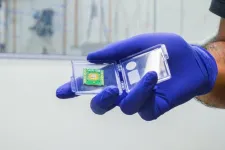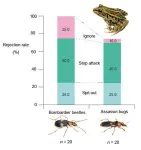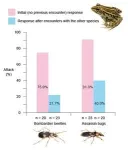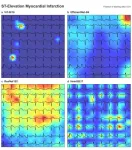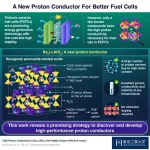(Press-News.org) A University of Minnesota Twin Cities-led team has developed a new superconducting diode, a key component in electronic devices, that could help scale up quantum computers for industry use and improve the performance of artificial intelligence systems. Compared to other superconducting diodes, the researchers’ device is more energy efficient; can process multiple electrical signals at a time; and contains a series of gates to control the flow of energy, a feature that has never before been integrated into a superconducting diode.
The paper is published in Nature Communications, a peer-reviewed scientific journal that covers the natural sciences and engineering.
A diode allows current to flow one way but not the other in an electrical circuit. It’s essentially half of a transistor, the main element in computer chips. Diodes are typically made with semiconductors, but researchers are interested in making them with superconductors, which have the ability to transfer energy without losing any power along the way.
“We want to make computers more powerful, but there are some hard limits we are going to hit soon with our current materials and fabrication methods,” said Vlad Pribiag, senior author of the paper and an associate professor in the University of Minnesota School of Physics and Astronomy. “We need new ways to develop computers, and one of the biggest challenges for increasing computing power right now is that they dissipate so much energy. So, we’re thinking of ways that superconducting technologies might help with that.”
The University of Minnesota researchers created the device using three Josephson junctions, which are made by sandwiching pieces of non-superconducting material between superconductors. In this case, the researchers connected the superconductors with layers of semiconductors. The device’s unique design allows the researchers to use voltage to control the behavior of the device.
Their device also has the ability to process multiple signal inputs, whereas typical diodes can only handle one input and one output. This feature could have applications in neuromorphic computing, a method of engineering electrical circuits to mimic the way neurons function in the brain to enhance the performance of artificial intelligence systems.
“The device we’ve made has close to the highest energy efficiency that has ever been shown, and for the first time, we’ve shown that you can add gates and apply electric fields to tune this effect,” explained Mohit Gupta, first author of the paper and a Ph.D. student in the University of Minnesota School of Physics and Astronomy. “Other researchers have made superconducting devices before, but the materials they’ve used have been very difficult to fabricate. Our design uses materials that are more industry-friendly and deliver new functionalities.”
The method the researchers used can, in principle, be used with any type of superconductor, making it more versatile and easier to use than other techniques in the field. Because of these qualities, their device is more compatible for industry applications and could help scale up the development of quantum computers for wider use.
“Right now, all the quantum computing machines out there are very basic relative to the needs of real-world applications,” Pribiag said. “Scaling up is necessary in order to have a computer that's powerful enough to tackle useful, complex problems. A lot of people are researching algorithms and usage cases for computers or AI machines that could potentially outperform classical computers. Here, we’re developing the hardware that could enable quantum computers to implement these algorithms. This shows the power of universities seeding these ideas that eventually make their way to industry and are integrated into practical machines.”
This research was funded primarily by the United States Department of Energy with partial support from Microsoft Research and the National Science Foundation.
In addition to Pribiag and Gupta, the research team included University of Minnesota School of Physics and Astronomy graduate student Gino Graziano and University of California, Santa Barbara researchers Mihir Pendharkar, Jason Dong, Connor Dempsey, and Chris Palmstrøm.
END
New superconducting diode could improve performance of quantum computers and artificial intelligence
U of M researchers’ device is more energy efficient and versatile than past models
2023-06-06
ELSE PRESS RELEASES FROM THIS DATE:
Motor skills and physical activity practice supports preschoolers’ learning
2023-06-06
A doctoral thesis has demonstrated that motor skills and physical activity practice can support the cognitive and early academic skills of preschoolers, particularly when the activities include motor skills practice, or when motor skills or physical activity practice is combined with the subject to be learnt.
In recent years, concerns have been raised about children and adolescents being less physically active and having weaker motor skills than previous generations. A further cause of concern is the decline of for instance mathematical and language skills, with an increasing number of children ...
Mount Sinai researchers use new deep learning approach to enable analysis of electrocardiograms as language
2023-06-06
New York, NY (June 6, 2023) – Mount Sinai researchers have developed an innovative artificial intelligence (AI) model for electrocardiogram (ECG) analysis that allows for the interpretation of ECGs as language. This approach can enhance the accuracy and effectiveness of ECG-related diagnoses, especially for cardiac conditions where limited data is available on which to train.
In a study published in the June 6 online issue of npj Digital Medicine DOI: 10.1038/s41746-023-00840-9, the team reported that its new deep learning model, known as HeartBEiT, forms a foundation upon which specialized diagnostic models can be created. The team noted that in comparison ...
Ba2LuAlO5: A new proton conductor for next-generation fuel cells
2023-06-06
The discovery of Ba2LuAlO5 as a promising proton conductor paints a bright future for protonic ceramic fuel cells, report scientists from Tokyo Tech. Experiments show that this novel material has a remarkably high proton conductivity even without any additional chemical modifications, and molecular dynamics simulations reveal the underlying reasons. These new insights may pave the way to safer and more efficient energy technologies.
When talking about sustainability, the ways in which a society ...
Fine-tuning 3D lab-grown mini tumors to help predict how patients respond to cancer therapies
2023-06-06
Scientists from the UCLA Jonsson Comprehensive Cancer Center have developed a new method to bioprint miniature tumor organoids that are designed to mimic the function and architecture of real tumors. The improved process allows researchers to use an advanced imaging method to study and analyze individual organoids in great detail, which can help researchers identify personalized treatments for people with rare or hard-to-treat cancers.
The method is described in the journal Nature Communications.
“Tumor organoids have become fundamental tools to ...
Social media ‘trust’/’distrust’ buttons could reduce spread of misinformation
2023-06-06
The addition of ‘trust’ and ‘distrust’ buttons on social media, alongside standard ‘like’ buttons, could help to reduce the spread of misinformation, finds a new experimental study led by UCL researchers.
Incentivising accuracy cut in half the reach of false posts, according to the findings published in eLife.
Co-lead author, Professor Tali Sharot (UCL Psychology & Language Sciences, Max Planck UCL Centre for Computational Psychiatry and Ageing Research, and Massachusetts Institute of Technology) said: “Over the past few years, the spread of misinformation, or ‘fake news’, has skyrocketed, ...
Programmable 3D printed wound dressing could improve treatment for burn, cancer patients
2023-06-06
One of the challenges in treating burn victims is the frequency of dressing changes, which can be extremely painful.
To bring relief to this and other problems, University of Waterloo researchers have created a new type of wound dressing material using advanced polymers. This new dressing could enhance the healing process for burn patients and have potential applications for drug delivery in cancer treatment as well as in the cosmetic industry.
"To treat burn victims, we can customize the shape using a 3D printer, secondly, the material has fine-tuned surface adhesion, which is a key feature", said Dr. Boxin Zhao, a professor in Waterloo's Department of ...
Do chatbot avatars prompt bias in health care?
2023-06-06
Chatbots are increasingly becoming a part of health care around the world, but do they encourage bias? That’s what University of Colorado School of Medicine researchers are asking as they dig into patients’ experiences with the artificial intelligence (AI) programs that simulate conversation.
“Sometimes overlooked is what a chatbot looks like – its avatar,” the researchers write in a new paper published in Annals of Internal Medicine. “Current chatbot ...
Team develops smartphone app to enhance midwifery care in Tanzania
2023-06-06
An international research team from Tanzania and Japan created a smartphone app and conducted a pilot study of how the app might be used to improve midwives’ knowledge and skills in Tanzania. Their study focused on the app’s potential effects on the learning outcomes of midwives and birth preparedness of pregnant women in Tanzania.
The team’s work is published in the journal PLOS ONE on March 31, 2023.
“The smartphone app for midwives showed significant improvements in their learning outcomes, leading to better birth preparations for pregnant women in Tanzania. This study highlights the potential of leveraging technology ...
Webb telescope detects universe’s most distant organic molecules
2023-06-06
An international team of astronomers has detected complex organic molecules in the most distant galaxy to date using NASA’s James Webb Space Telescope.
The discovery of the molecules, which are familiar on Earth in smoke, soot and smog, demonstrates the power of Webb to help understand the complex chemistry that goes hand-in-hand with the birth of new stars even in the earliest periods of the universe’s history. At least for galaxies, the new findings cast doubt on the old adage that where there’s smoke, there’s ...
Breastfeeding for longer may be linked to better exam results in later life
2023-06-06
Children who are breastfed for longer appear to be more likely to gain slightly better results in their school GSCEs at age 16 compared with non-breastfed children, suggests a study published online in the journal Archives of Disease in Childhood.
The evidence of improved educational outcomes is still apparent even when various factors are taken into account such as people’s socio-economic status and their parents’ intelligence.
Previous studies have suggested that children breastfed for longer have improved educational outcomes later in life. However these are relatively scarce, and ...
LAST 30 PRESS RELEASES:
Tec-Dara combination offers substantial improvement over standard second-line therapies for relapsed or refractory multiple myeloma
Improving treatment for an autoimmune bleeding condition
Drug reduced need for blood transfusions during hospitalization for non-cardiac surgery
Novel agent ianalumab added to standard therapy extends time to treatment failure in patients with previously treated immune thrombocytopenia
Pirtobrutinib outperforms bendamustine plus rituximab for previously untreated CLL/SLL
Online tracking and privacy on hospital websites
A freely available tool to document wartime destruction
Residential solar panels can raise electricity rates
Scientists use synthetic platelets as ‘Trojan horse’ drug-delivery system
Cooperative Intermolecular Interactions Regulate Supramolecular Polymer Assembly
Korea University researchers develop ultrasensitive method to detect low-frequency cancer mutations
First patient enrolled in GOG-3133/ FRAmework-01 phase 3 study evaluating sofetabart mipitecan (LY4170156), a novel ADC targeting folate receptor alpha (FRα), in recurrent ovarian cancer
Two Hebrew University researchers win prestigious ERC consolidator grants
ERC grant helps to quantify the impact of anthropogenic air pollution particles on climate
Exercise might help improve mobility during aging
New online tool detects drug exposure directly from patient samples
Learn the surprising culprit limiting the abundance of Earth’s largest land animals
Study reveals new ways the brain regulates communication between neurons
Research reveals new hybrid state of matter where solids meet liquids
Researchers develop a new computational tool to understand how genetic interactions impact human traits
Elephants, giraffes and rhinos go where the salt is
Cancer loses its sense of time to avoid stress responses
The twisted nanotubes that tell a story
Flaring black hole whips up ultra-fast winds
Study explores the link between newspaper preference and attitudes towards autism
Artificial turf in the Nordic climate – a question of sustainability
The hidden toll of substance use disorder: annual cost of lost productivity to US economy nearly $93 billion
Among psychologists, AI use is up, but so are concerns
Recycling a pollutant to make ammonia production greener
Common institutional ownership linked to less aggressive business strategies in Chinese firms
[Press-News.org] New superconducting diode could improve performance of quantum computers and artificial intelligenceU of M researchers’ device is more energy efficient and versatile than past models
